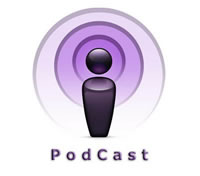Difference between revisions of "Workshops/Launching and Managing Podcasts"
DSantiago08 (talk | contribs) (Blanked the page) |
|||
| Line 1: | Line 1: | ||
| + | [[File:podcasting.jpg|right]] | ||
| + | ==Session Information== | ||
| + | *'''Level''' - Introductory, no previous experience with podcasting required | ||
| + | |||
| + | *'''Audience''' - Instructors interested in integrating audio and video podcasts into their courses | ||
| + | |||
| + | *'''Time''' - 50 minutes | ||
| + | |||
| + | *[[File:register_disabled.gif|60px|link=Workshops/Interested_in_a_Workshop]] | ||
| + | |||
| + | ==Before the Session== | ||
| + | |||
| + | This session is hands-on, so please bring your laptop if possible. If you cannot bring a laptop, one will be provided for you. | ||
| + | |||
| + | ==General Description== | ||
| + | |||
| + | Although instructors have long been able to publish audio and video files online and tools like YouTube make that process even easier today, the term "podcasting" refers to a related practice in which students subscribe to an ongoing series of audio or video episodes. Typically, links to these episodes and/or the files themselves are downloaded to a student's mobile device (e.g., laptop, iPod, smartphone) automatically and are played using some sort of local media player software (e.g., iTunes). Learn how to build and manage your own course podcast in our WSU iTunes U installation. | ||
| + | |||
| + | ==Learning Outcomes== | ||
| + | |||
| + | Following this session, you will be able to... | ||
| + | |||
| + | *Describe how podcasting differs from simple multimedia file download, streaming, and Tegrity lecture capture solutions | ||
| + | *Download and install Audacity for audio podcast production | ||
| + | *Record and save simple MP3 audio files using Audacity | ||
| + | *Publish MP3 audio files to the public or private WSU instance of iTunes U | ||
| + | *Describe how video podcasting compares to the use of Tegrity for lecture capture | ||
| + | *Use Camtasia Studio (PC) or ScreenFlow (Mac) to create simple, screen-capture video podcasts | ||
| + | *Publish MP4 video files to the public or private WSU instance of iTunes U | ||
| + | *Direct your students how to subscribe to your audio and video podcasts through iTunes | ||
| + | |||
| + | ==Related Articles and Links== | ||
| + | |||
| + | *[[About TLT Scheduled Workshops|TLT Workshop Catalog]] | ||
| + | |||
| + | [[Category:podcasting]][[Category:workshops]] | ||
Revision as of 17:26, 12 April 2012
Session Information
- Level - Introductory, no previous experience with podcasting required
- Audience - Instructors interested in integrating audio and video podcasts into their courses
- Time - 50 minutes
Before the Session
This session is hands-on, so please bring your laptop if possible. If you cannot bring a laptop, one will be provided for you.
General Description
Although instructors have long been able to publish audio and video files online and tools like YouTube make that process even easier today, the term "podcasting" refers to a related practice in which students subscribe to an ongoing series of audio or video episodes. Typically, links to these episodes and/or the files themselves are downloaded to a student's mobile device (e.g., laptop, iPod, smartphone) automatically and are played using some sort of local media player software (e.g., iTunes). Learn how to build and manage your own course podcast in our WSU iTunes U installation.
Learning Outcomes
Following this session, you will be able to...
- Describe how podcasting differs from simple multimedia file download, streaming, and Tegrity lecture capture solutions
- Download and install Audacity for audio podcast production
- Record and save simple MP3 audio files using Audacity
- Publish MP3 audio files to the public or private WSU instance of iTunes U
- Describe how video podcasting compares to the use of Tegrity for lecture capture
- Use Camtasia Studio (PC) or ScreenFlow (Mac) to create simple, screen-capture video podcasts
- Publish MP4 video files to the public or private WSU instance of iTunes U
- Direct your students how to subscribe to your audio and video podcasts through iTunes
